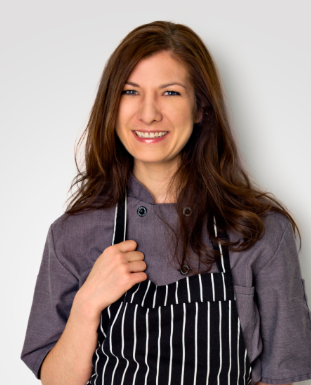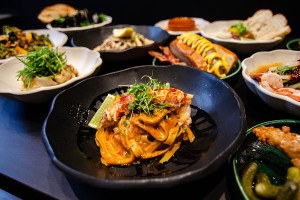Catching Up with Clio Pastry Chef Monica Glass
 Earlier this morning, Food & Wine announced the East Coast nominees for the title of “The People’s Best New Pastry Chef.” Repping Boston? Chefs Brian Mercury of Harvest (check out his pastry toolkit here) and Monica Glass of Clio. Glass’s nomination is particularly notable, considering that she’s only been at Ken Oringer’s fine-dining flagship (and in Boston as a whole) for a mere six months, coming from Philadelphia restaurants like FISH and 10 Arts Bistro & Lounge in Philadelphia. To get to know the 29-year-old a bit better, we caught up with her on the phone while she was at work in the Clio pastry kitchen. Ahead, find out what inspires her, and the candy that she reaches for every morning.
Earlier this morning, Food & Wine announced the East Coast nominees for the title of “The People’s Best New Pastry Chef.” Repping Boston? Chefs Brian Mercury of Harvest (check out his pastry toolkit here) and Monica Glass of Clio. Glass’s nomination is particularly notable, considering that she’s only been at Ken Oringer’s fine-dining flagship (and in Boston as a whole) for a mere six months, coming from Philadelphia restaurants like FISH and 10 Arts Bistro & Lounge in Philadelphia. To get to know the 29-year-old a bit better, we caught up with her on the phone while she was at work in the Clio pastry kitchen. Ahead, find out what inspires her, and the candy that she reaches for every morning.
LM: How long have you known you wanted to go into pastry?
MG: I guess since I was 21. It was more the artistic side of it and the science side of it for me. I never wanted to focus on science because it’s not my brain, but I like that it’s part of pastry and I really like art, and expressing myself in a more artistic fashion.
What’s your go-to, favorite dessert?
Absolutely apple crisp or any type of fruit crisp with a crunchy topping or a big scoop of ice cream. And I eat Reeses Pieces every morning for breakfast.
So I understand that you’re a gluten-free eater yourself. How has that influenced your desserts?
I was diagnosed about 4 years ago. It was an extreme challenge at first, but I definitely adapted to it and learned more. It’s been trial and error. It has a huge impact on how I make my desserts—I always try to make something gluten-free. I actually just started using mochi flour [for cookies], and it works awesomely. You don’t have to use xanthan gum or anything. They hold their shape.
How would you characterize your pastry style? It seems to veer savory [see: desserts like meyer lemon beignets with black currant, pine nuts, olive, and burnt-honey ice cream].
Overall, definitely playful. My taste buds naturally crave salty foods, like cheese, chips, and french fries. I guess that’s just kind of where I lean. I like savory things, but I like desserts because it’s an extra something that makes people happy. I always try to keep that in mind. I just find a lot of interest in savory things.
When you came to Clio, were there dishes that Ken Oringer asked you to keep?
The Kouign-Amann had to stay, but I changed it from what they were doing previously— I wasn’t a big fan of it. The actual recipe, I changed that completely, but it’s the same basic dessert. It’s just my own now. The chocolate coulant also had to stay. It’s still chocolate-coconut, but I got the OK to change that. It’s an ode to [chef] Michel Bras.
How do you typically plan your menu? What inspires you?
Obviously seasonally; I always think about what fruits are coming into season first. It really depends where inspiration comes from. I usually try to tie it into an experience or something that reminds me of a specific time. The apple crisp that I had on for the fall menu, that was because my favorite dessert is an apple crisp a la mode, super simple with a glass of rye whiskey on the side. I tried to get more elements of warm, cold, and crunchy.
What’s in the works for spring?
I’m thinking of all my spring ideas now; I’m definitely going to play around with rhubarb, and lovage. I want to make a lovage ice cream, but not sure what for yet. I get very excited about springtime fruit. Right now it’s a weird time, because things are just starting to come in.
Any dessert trends that you love?
I try to stay away from trends. I look to Francisco Migoya, the pastry chef at the CIA, for inspiration. He’s always experimenting with new things.
Any you hate?
One thing I hate is calling sauces “gels.” I know they are technically fluid gels, but that does not sound appetizing for me.
What’s the biggest difference for you between composed, deconstructed desserts and just a big wedge of chocolate cake?
I don’t like the word “deconstruction.” What I try to do is not a deconstruction of a dessert, but a composition of elements that come together harmoniously. Deconstruction implies breaking things down. At the end of the day, what you want your diner to eat has to be comforting and familiar enough that they get it, but I feel like the fine dining restaurants afford us the opportunity to play around and make [desserts] more intriguing. There’s always an element of nostalgia and comfort in what I am doing. You don’t want people to be completely weirded out.
For more online food coverage, find us on Twitter at @ChowderBoston


